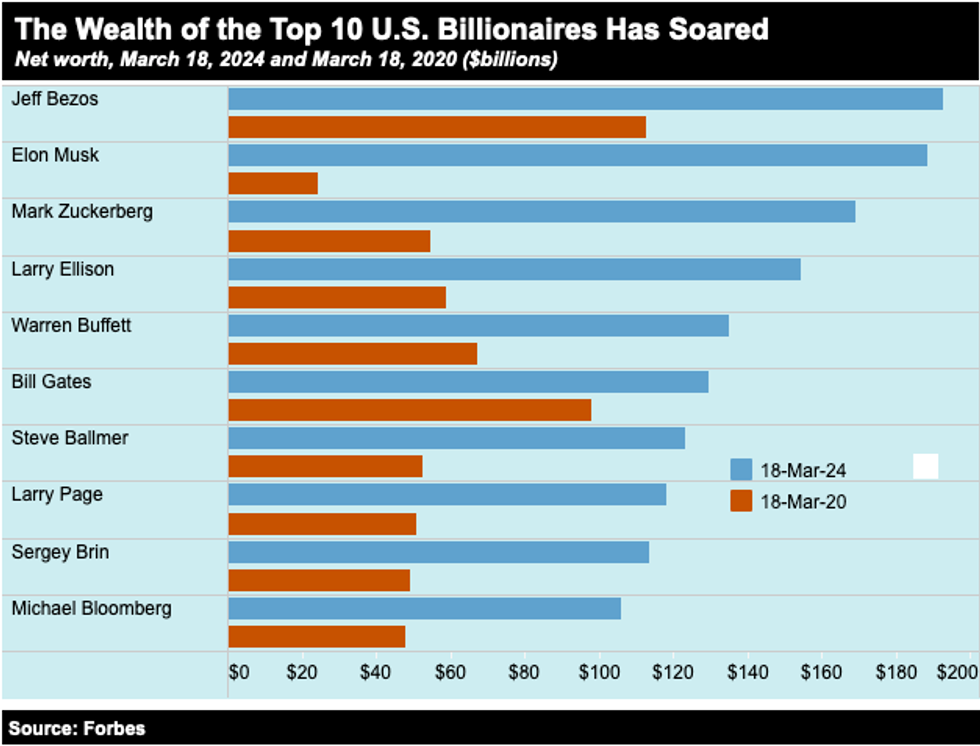"Donations from small donors have been on a twenty-year downward trend, as low- and middle-income donors feel the squeeze from stagnant wages, declining savings and homeownership, the Great Recession of 2008, and now the pandemic."
We should approach billionaire giving announcements with a healthy skepticism, especially when it involves only 3 percent of their wealth. But her actions show a positive path forward at a time when philanthropy has become increasingly "top heavy" with billionaire power.
As a new report I co-authored with Helen Flannery reveals, the giving sector now mirrors the larger income and wealth inequality trends ravaging all aspects of society.
Here's the picture: Donations from small donors have been on a twenty-year downward trend, as low- and middle-income donors feel the squeeze from stagnant wages, declining savings and homeownership, the Great Recession of 2008, and now the pandemic.
Meanwhile, almost all the growth in charitable giving has come from wealthy donors. A third of all charitable deductions are now claimed by households making over $1 million.
This concentration of giving power in the hands of the richest 0.1 percent is bad for the nonprofit sector, democracy, and the integrity of the tax system. Philanthropy is at risk of becoming another extension of the private power of plutocrats, alongside monopoly ownership and media domination.
Unlike low- and middle-income givers, wealthy donors are more likely to park assets in private foundations and donor-advised funds, slowing its flow to working nonprofits on the ground. Between 2005 and 2019, the number of private foundations grew from 71,097 to 119,791, an increase of 68 percent. Over the same period, their assets grew 118 percent, from $551 billion to $1.2 trillion.
"Concentration of giving power in the hands of the richest 0.1 percent is bad for the nonprofit sector, democracy, and the integrity of the tax system. Philanthropy is at risk of becoming another extension of the private power of plutocrats, alongside monopoly ownership and media domination."
Donations to DAFs (Donor-Advised Funds) have increased even more rapidly, from $20 billion in 2014 to more than $37 billion in 2018--86 percent growth over just five years. DAFs have seen their share of the giving pie triple between 2010 and 2018, with the single biggest recipient of charitable funds being the Fidelity Charitable Gift Fund.
There are several reasons to applaud MacKenzie Scott's approach. She is not intending to park money in perpetuity in a private foundation or DAF (that we know of). Scott pledged "to give the majority of wealth back to the society that helped generate it, to do it thoughtfully, to get started soon, and to keep at it until the safe is empty."
Scott recognizes she holds a "privilege dividend" and the responsibility of not only giving the wealth, but also lifting up the organizations doing the work. She has pulled advisors from communities of color to identify grant recipients, stating that "people with experience with inequities are the ones best equipped to design solutions."
She disrupts the narrative of entitlement and deservedness that many billionaires have by acknowledging, "There is no question in my mind that anyone's personal wealth is the product of a collective effort, and of social structures which present opportunities to some people, and obstacles to countless others." This is a refreshing departure from the "I'm rich because I'm the smartest man in the universe" narrative you hear from the others.
As the Giving Pledge turns 10 years old next week, the other pledgers should take notice of both how MacKenzie Scott is giving and where the money is going.
Started in August 2010 by Bill Gates and Warren Buffett, the Giving Pledge enlists billionaires to give away half their wealth. But based on our analysis in the new report--titled "Gilded Giving 2020: How Wealth Inequality Distorts Philanthropy and Imperils Democracy"--the assets of living Giving Pledge members have doubled over the last decade. Basically, their wealth is growing faster than their capacity to give it away. And the wealth of the 100 living U.S. Giving Pledgers has surged $214 billion over the last four months, since the beginning of the pandemic.
Many Giving Pledge members will fulfill their Pledge by plopping assets into private family foundations controlled by their heirs, possibly in perpetuity. Not enough are aggressively moving funds directly to working charities, as MacKenzie Scott has begun to do.
Voluntary efforts are insufficient. It is time for Congress to update the rules governing philanthropy to discouraging the warehousing of trillions, increase the flow, and protect the nonprofit sector and the integrity of the tax system from abuses.
"Voluntary efforts are insufficient. It is time for Congress to update the rules governing philanthropy to discouraging the warehousing of trillions, increase the flow, and protect the nonprofit sector and the integrity of the tax system from abuses."
For starters, federal lawmakers should institute an Emergency Charity Stimulus to mandate a higher foundation payout for the next three years and the implementation of a DAF payout. This would move an estimated $200 billion over three years in charitable dollars off the sidelines to frontline charities without costing taxpayers additional funds.
But we need a long-term "charity reform" program that ensures that philanthropy doesn't reinforce the patterns of plutocracy and concentrated power. Congress should levy wealth taxes on closely controlled family foundations. Until the money is moved to more democratic decision-making systems, the wealth should be treated as part of private wealth holdings.
This will encourage donors to move more funds to democratically controlled foundations or, better yet, transfer funds to public-interest charities controlled by those historically excluded from wealth ownership. As Edgar Villanueva has proposed, billionaire philanthropists should start with a 10 percent tithe of their wealth to foundations controlled by Black, Indigenous, and other people-of-color led initiatives.
Just as we don't want an economy that produces billionaires, we don't want a charity sector that creates billionaire-controlled foundations.



